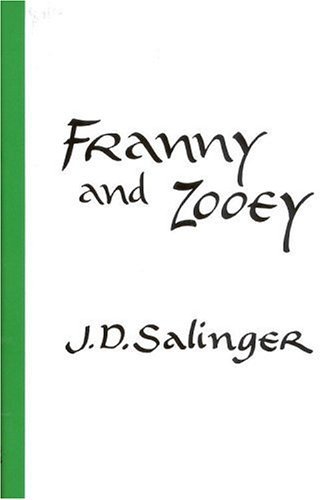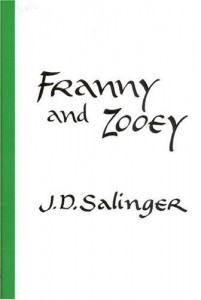Publication Details:
Character List:
Plot Synopsis:
Leslie’s Notes:
- Story is part of Salinger’s 3rd published book (Franny and Zooey, 1961), but originally appeared in New Yorker in January 29, 1955. Published together as book because both stories take place over the same weekend in November of 1955.
- Evidence has shown Franny was originally not intended to be a member of the Glass family, as you don’t see any reference to her last name or her siblings names in the story . . . or any reference to her in Salinger’s earlier Glass family stories (Alsen). There are many contradictions in “Zooey” that reflect this as well. John Updike even mentions that, “the Franny of ‘Franny and the Franny of ‘Zooey’ are not the same person.” In Dream Catcher, Salinger’s daughter explains that “Franny” was written as a gift to Salinger’s wife, Claire, and that Salinger wrote Franny’s original character to mimic his bride, but later had to change things about her character to make her fit into the Glass family (Alsen and French).
- In the order they were written by Salinger, “Franny” is the 2nd of the Glass family stories, the first being “A Perfect Day for Bannafish (1948).
Critical Reception:
- Overall the reviews were positive, with one review (Gwynn and Blotner) going so far as to say that Franny, “is the best chapter in the Glass history.”
- One poor review by Maxwell Geismar claimed that the story, “leaves an unpleasant or disagreeable impression . . . with descriptions of Western materialism and Eastern spiritualism that are hardly convincing.” He went on to say that, “both the central characters become almost equally unpleasant toward the close.”
- Joan Didion wrote in November of 1961: “Franny and Zooey is finally spurious because of Salinger’s tendency to flatter the essential triviality within each of his readers, his prediction for giving instructions for living” (Sublette).
- Frank Kermode wrote in June of 1962 that Salinger: “very carefully writes for an audience he deplores, an audience that disposes of a certain amount of smart cultural information and reacts correctly to fairly complex literary stimuli: an audience that is familiar with Creative Writing, and has a strong stiffening of people who have turned in pretty good papers on Flaubert or Faulkner” (Sublette).
The Meat of the Story:
- Franny Glass and Lane Coutell, both wealthy college students, meeting up for a Yale football game at what many critics have assumed is Princeton. “Collegiately dogmatic”
- “Tuesday I think” as date of letter
- Beginning of story describes specifically the stereotypical Ivey League college student, as put less subtly when Franny says, “Everyone else on the train, looked very Smith, except for two absolutely Vassar types and one absolutely Bennington or Sarah Lawrence.”
- As the couple enters the restaurant, the description of materialism and superficial judgments continues, emphasizing how important appearances and social protocol are in this environment. Sickler’s is on, “the intellectual fringe of students at the college.”
- Sidenote: Lane says “goddam” way to goddam much
- Lane is pretentious and Franny is apologetic for being disinterested in him even calling herself “mad” and “destructive.” He grows more and more irritated with her. Neither one of them really listen to the other when they are having their conversation.
- “It was very clear that the sense of well being he had felt, a half hour earlier, at being in the right place with the right, or right-looking, girl was now totally gone.”
- “ . . . preferably attractively bored.” Lane’s thoughts on being left alone at table.
- After Franny cries in the bathroom she feels a “momentous change of polarity . . . inside of her mind . . . immediate, pacifying effect on her body.”
- Section men and Wally Campbell, we all know them . . . and her description of his type takes Lane beyond irritation to being offended. Franny is still apologetic and shows self-hatred, self-loathing, and claims to be losing her mind.
- “I’m sick of not having the courage to be an absolute nobody.”
- The Way of the Pilgrim: her interest/description, his disinterest/criticism . . . calls it “mumbo-jumbo.”
- After a lunch that displays two completely disconnected people, Lane says, awkwardly, “Anyway. Just in case I forgot to mention it. I love you. Did I get around to mentioning that?”
- After her collapse, Lane takes masculine role or taking care of her, but still holds a controlling and insensitive presence.
- Last paragraph: “Alone, Franny lay quite still, looking at the ceiling. Her lips began to move, forming soundless words, and they continued to move.” What do you think she was saying? Was she praying like she read about in her book?
Critical Analysis:
The story features a conventional narrative structure, but the narrative perspective shifts from 3rd person omniscient to third person objective near the end.
The central characters are similar to those featured in “Bannafish,” featuring a conflict between what scholars have labeled a spiritual and unspiritual person, or in this case, an idealist and a materialist (Alsen).
This story is the first to deal with religious beliefs, but as seen in his later work, the religious concepts discussed here are from a Christian perspective. Salinger later gets into Taoism, Advaita Vedanta, and Zen Buddhism in later Glass stories (Alsen).
The themes, phoniness of American middle-class life, conflict between the idealist and materialist, and the impossibility of leading a spiritual life in America are all connected to many of Salinger’s later works, with only the conflict between spiritual and material values rooting back to “Bannafish” (Alsen).
Franny is “sincerely upset by the egocentrism of the world that has engulfed her, awkwardly struggling and partially succeeding in finding some spiritual sustenance even if it ruins her ‘normal’ role in a conventional boy-girl situation” (Gwynn and Botner). These critics reject the notion that Franny is pregnant and having an emotional and physical reaction to that.
Symbolic connections to other stories: the chicken sandwich scorned by Lane and untouched by Franny calls up the symbolic chicken sandwich of “Just Before the War with the Eskimos” which Franklin offers and which Ginnie finally accepts in a gesture of charitable love (Gwynn and Botner).
Warren French on Franny being pregnant: “I just couldn’t accept the idea, because if this were simply the story of a girl’s guilt feelings during a bout of morning sickness, her nervous hysteria and her escort’s over-bearing insensitivity were reduced to comic-strip simplicity by the story’s erotic overtones. Besides, I could not see why any author would want to diminish the impact of the most telling satire on academic life” (French).
French describes Lane’s shortcoming as not an absorption in his work and himself, but in his loving Franny not for herself but for what she does for his ego.
Franny says, “I’m sick of just liking people. I wish to God I could meet somebody I could respect,” implying she has only ever liked poets in school or Lane, and never has respected them (French).
Jai Dev argues in the Journal of American Studies a number of implications for the use of Flaubert in the story, but most interestingly suggests that Salinger is mockingly revealing how pretentious Lane truly is by all of his behavior contradicting the theories of Flaubert himself—and that Salinger and Franny are intended to notice this and place judgment upon him.
Sources:
Alsen, Eberhard. A Reader’s Guide to J.D. Salinger. Greenwood Press: Wesport, Connecticut, 2002.
Dev, Jai. “Franny and Flaubert.” Journal of American Studies, Vol 25, No.1 (April 1991), pp. 81-85.
French, Warren. J.D. Salinger. Twayne Publishers: Boston, 1963 revised 1976.
Gwynn, Frederick L. and Blotner, Joseph L. The Fiction of J.D. Salinger. University of Pittsburgh Press: Pittsburgh, 1958.
Sublette, Jack R. J.D. Salinger: An Annotated Bibliography, 1938-1981. Garland Publishing, Inc.: New York, 1984.


